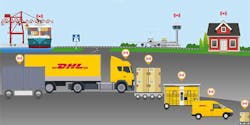There has been a lot of writing about the Internet of Things (IoT) and how it is going to affect almost every global industry, from retail to transportation. IoT is set to revolutionize the supply chain—both in terms of its operational efficiencies and revenue opportunities—by making it transparent.
In the present day, the supply chain is not just a way to keep track of your product, but also a way to gain an edge on your competitors by building your own brand. In this article, we will look at the different areas where we will be seeing the most advancements and change with the ever-advancing Industrial IIoT.
Running Retail Stores with the IoT
Combining RFID-tagged products with closed-circuit TV cameras can monitor customer movement and behavior. The connected store can trace how shoppers move from aisle to aisle that could offer insight to buying behavior. Information on buying behavior helps retailers provide user-specific deals, planning dynamic pricing, and streamlining operations.
While keeping people’s personal information safe is growing concern, face recognition might enable targeted advertising even in the absence of carrying an electronic device (Credit: Clickz)
Shopper-centric movement data can help streamline overall retail operations by making appropriate arrangement of stock and manpower.
Transport and Logistics with IoT
Retailers facing challenging logistics are implementing IoT solutions to improve traceability. Retailers can now follow goods in transit from warehouses to delivery.
Perishable items like pharmaceuticals can be constantly monitored in the warehouse for temperature, humidity, and other factors. In case of any damaged goods, documentation is provided with details the time and location of the damage and strengthens accountability. Cargotec and DHL are among the companies using IoT in logistics to monitor their operations, increasing visibility and saving costs. The technology also helps to track trucks in real-time and predict demand for certain goods in the warehouses, helping to keep up with the ever-changing face of online sales.
The smallest changes in warehouse management can cost or save a corporation millions. (Credit: Snyxius)
IoT and Retail Operations
The huge warehouses where the retail giants have their inventory stockpiled are working to make some advancements with the aid of the Internet of Things. Considering the size of the warehouses, it is becoming an arduous task for floor workers to locate a product physically and bring it back for pre-delivery in time.
The IoT facilitates a connected warehouse with shelf sensors. An IoT platform has the capability to signal an autonomous robotic cart for collecting goods and bringing it back to the shipping area. This technology saves manual labor and adds transparency to operations. The same sensors can also signal a re-order when the inventory reaches a set level. Autonomous re-ordering avoids running out of stock, a common problem for many retailers.
RFID tags and sensors can help with inventory accounting, which helps to improve stocking and thereby increase profits. This will help the retailers to take customer-centric decisions on the go and elevate the customer experience.
As the amount of consumer data that gets generated increases, this technology and approach will become more beneficial. The retail enterprises are getting a gist of what products consumers desire that are not available in the market. With this data, they can further approach a manufacturer with a product idea that can be unique and exclusive to the retailer, offering a competitive edge and strengthening customer loyalty.
More retailers are moving toward IoT advancements and implementing some sort of IoT solution. For instance, Walmart has filed a patent to incorporate a self-driving cart in its floor operations to increase efficiency.
The Road Ahead
It can be difficult to adopt change, but it is mandatory as technology is creating a differentiator between brands by becoming a vital factor in order to stay relevant. If you fail to do so you might likely result in being left behind by more tech-savvy companies. Keep learning!
Vikash Kumar manages online campaigns for Tatvasoft.com. You can follow him on LinkedIn and Twitter.



